IN THIS ISSUE
- A big tree for big spaces
- Watch: DNR dolphin rescue
- Bird news: youth winners, Joro worries
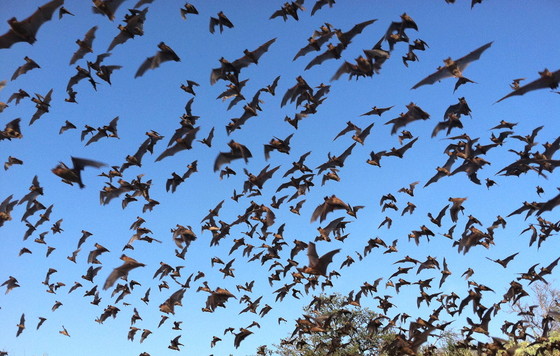 Studies rate Brazilian free-tailed bats one Earth's fastest mammals. (Ann Froschauer/USFWS)
Brazilian free-tailed bats are one of the 16 bat species native to Georgia. But make no mistake, their speed sets them apart. As does their ability to fly high and far.
Also called Mexican free-tailed bats, these small bats with narrow, long wings have been clocked at a blistering 99 mph in level flight. That makes them one of the world’s fastest mammals.
They also can fly as high as 10,000 feet, although often they’re only a half-mile or so up. And although they usually feed within a 50-mile radius of their day roosts, they can forage as far as 150 miles away in a night, says Katrina Morris, a program manager with DNR's Wildlife Conservation Section.
Brazilian free-tailed bats are big eaters, too. In Texas, they and other “house” bats eat an estimated 6,600 to 19,800 tons of insects a year, limiting damage to crops.
So how can you help conserve these fast bats, and others? Two quick answers:
-
Buy an eagle or monarch butterfly license plate, or renew one of these or a hummingbird tag. Up to 80 percent of the $25 fee goes directly to wildlife.
-
Donate to the Georgia Wildlife Conservation Fund at gooutdoorsgeorgia.com. No account? No problem. Just click “Licenses and Permits” to create one.
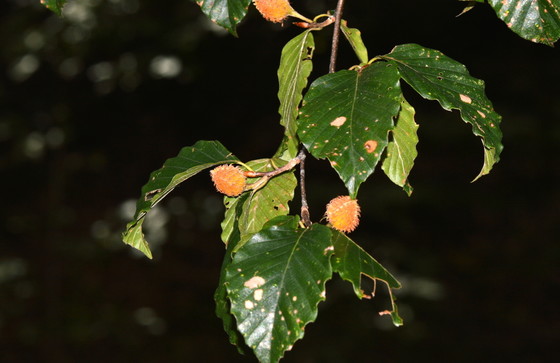 American beech on Big Lazer Creek WMA (Terry W. Johnson)
By TERRY W. JOHNSON
Most of the suggestions I offer about enhancing your property for wildlife are applicable to yards of almost any size. But this month, my recommendation is best for big yards – really big yards.
That’s because I’m talking about the American beech.
This tree is extremely valuable to wildlife, from its protein-packed beechnuts to its role as a host for some moths and butterflies and even as a source of insects that feed scores of bird species.
However, the slow-growing but potentially massive American beech – which can top 125 feet tall and sport a 60-foot-wide canopy – is not suited for average-sized yards.
That said, it’s a shame that beeches are hard to find these days. …
Read Terry’s column exploring the beauty and value of the American beech.
Terry W. Johnson is a retired DNR program manager and executive director of TERN, the Wildlife Conservation Section’s friends group. Check out past columns, his Backyard Wildlife Connection blog and his book “A Journey of Discovery: Monroe County Outdoors.” Permission is required to reprint his columns.
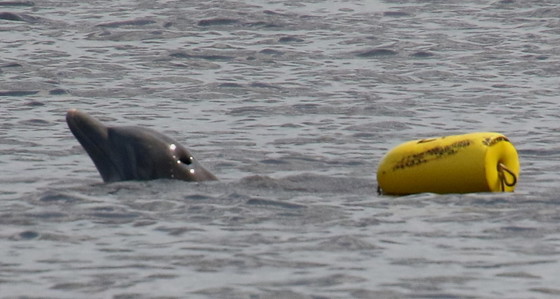 Weighed down by the crab trap, the entangled dolphin surfaces for air. (Ashley Raybould/DNR)
North Atlantic right whales entangled in commercial fishing gear is a familiar headline. But DNR staff also deal with a lesser-known entanglement: bottlenose dolphins caught in crab trap buoy lines.
While involving a much more common species and on a much smaller scale, these incidents can still mean life or death for the animal. Or in a case this summer, an adult dolphin and her calf.
Alerted by DNR Range Safety Officer Kevin Michaud to a dolphin in trouble near Richmond Hill Aug. 4, senior wildlife biologist Clay George and crew arrived to find the buoy rope of a trap wrapped tightly around the dolphin’s tail.
With the weight of the trap pulling her under, she struggled to surface and breathe.
Most dolphin entanglements are straightforward. Not this one. “She had managed to roll and twist over 20 feet of rope around her tail,” George said.
Complicating matters, dolphins can die suddenly from the stress of being entangled. The quicker they’re released, the better. And this dolphin had a calf close by, one too young to survive alone.
The four-person team followed a basic plan. Snag the line. Control the tail. Loosen and determine where to cut the rope – fast. Slice carefully. All while hanging onto a thrashing 300-pound mass of muscle.
It worked. The dolphin swam away rope-free. Her calf quickly joined her.
“It’s the second case I can think of where we disentangled a mom while its calf swam around nearby,” George said.
 Watch as DNR's Mark Dodd and others disentangle the mom dolphin. (Clay George/DNR)
Why dolphins get entangled is not clear. Some may be trying to steal the trap bait or playing with the rope or buoy, or maybe they're accidently caught as they swim past.
While not common, entanglement also isn’t a freak occurrence. The Aug. 4 incident was the third crab-trap entanglement reported in Georgia this year and the only one that did not end in death. DNR has documented 29 confirmed and suspected entanglements since 2000. Of those, 43 percent of the dolphins died.
Fortunately, this dolphin had not been entangled long. When the crabber had checked the trap that morning, she wasn’t there.
WHY NOT CUT FIRST
Here's why staff first loosen the rope and assess where to start cutting:
- Loosening makes it easier and safer to slice the rope without accidently cutting the dolphin.
- The approach helps ensure all of the rope is removed so the dolphin doesn’t swim away with any, raising the risk of infection and death by constriction.
When dolphins are entangled in a crab trap buoy rope, the trap acts like an anchor. As the animal twists, rolls and pulls, the rope cinches tighter around them.
WHAT YOU CAN DO
If you see an entangled, hurt or stranded dolphin, please report it immediately to DNR’s Marine Mammal Stranding Network, (800) 2-SAVE-ME (800-272-8363). Note the date, time, place and, if possible, the coordinates.
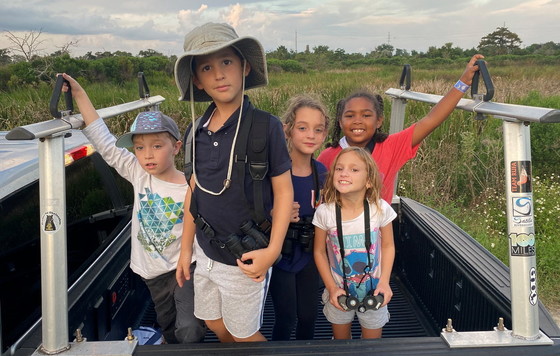 The Eagle Eyes, leaders in the Youth Birding Competition Primary School division (DNR)
DNR’s first virtual Youth Birding Competition connected 70 children and teens with birds in a nine-day contest capped by an online awards ceremony. Awesome Osprey, a middle-school team of Cornelia siblings, finished first with 148 species.
The popular birdathon, usually held in spring, was canceled by the pandemic in 2020 and switched this year to fall and a virtual format because of COVID-19. This marked the first time in the event's 15 years it was held in fall.
Fitting the times, event T-shirts included a tip to keep "two peregrines apart” (i.e., 6 feet), noting that “a pandemic can’t stop birders from spreading their wings.”
As Joro spiders spread across north Georgia, some hummingbird fans worry that the big Asian arachnids and their multi-layered webs pose a threat to hummers.
Small birds such as hummingbirds, kinglets and vireos sometimes get caught in the webs of large spiders, writes Dr. Bob Sargent, a program manager with DNR’s Wildlife Conservation Section. Although spider mouthparts are too small to take advantage of the trapped birds, researchers have reported finding dead hummers encased in webs, indicating that spiders wrapped them up.
The flipside, Sargent says, is that hummers will eat small spiders, and the birds often collect pieces of spider web to help anchor their nests to tree limbs.
Related: Raising cautions about Joros. Plus: Comparisons with native spiders (DNR guide; Center for Invasives Species and Ecosystem Health guide).
Georgia Audubon has a new tool for the public to help reduce migrating birds hitting buildings at night. The project with Colorado State University’s Dr. Kyle Horton provides nightly migration forecasts for the state, with Georgia Audubon issuing Lights Out Alerts when migration is more intense.
Georgia Audubon Conservation Director Adam Betuel said that while fall and spring migrations last weeks, more than half of the movement occurs on about 10 percent of the nights. The ability to forecast these nights in advance and alert the public to turn out lights “can save thousands of birds each migratory period.”
Bright lights – particularly concentrated in cities – can confuse and disorient birds migrating at night, often resulting in them colliding into buildings.
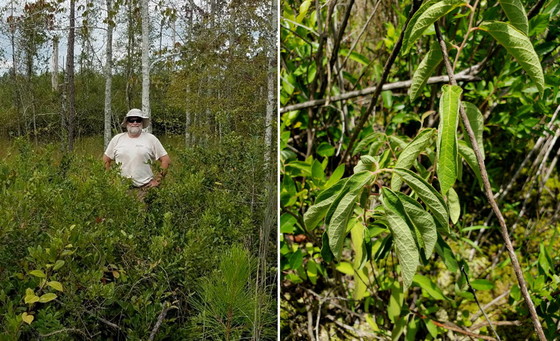 Pondberry at Mayhaw, left, and a plant closeup from another site (left, Lisa Kruse; right, Stephanie Koontz/DNR)
Two new stands of federally endangered pondberry have been found at Mayhaw Wildlife Management Area near Colquitt. The recent discovery by DNR staff is significant because of the population sizes – more than 5,000 stems in one area – the quality of the wetlands and the property’s protected status.
The Georgia Sea Turtle Cooperative monitored 2,500 sea turtle nests this year, at least 2,484 of them made by loggerheads. While fewer than 2020 (2,786 loggerhead nests) or 2019 (a record 3,950), the total exceeds the 32-year average and extends a 3.9 percent annual rise in nesting since 1989. Hatching updates.
Keep the sightings of eastern spotted skunks coming! The most recent, seen at a home in Blue Ridge, is helping DNR determine where to place cameras to better document and learn more about this declining skunk species. Report sightings.
The Coosa Summit, a virtual half-day event next Wednesday, will explore topics varying from monitoring bridled darters and blue shiners to using social media for conservation in the Coosa River watershed. Register by Monday.
 Gopher tortoise hatchlings at Warm Springs (Marylou Horan/DNR)
Need a dose of gopher tortoise cuteness? These hatchlings, many from clutches moved from developments, were hatched at Warm Springs National Fish Hatchery and are being head-started there so the juveniles have a better chance of survival when released in the wild. Watch them hatch.
Quick hits:
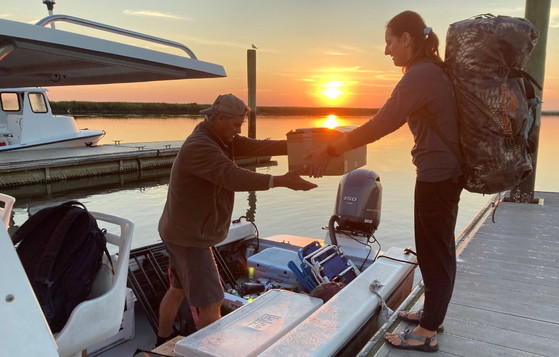 Sunrise sendoff for sea turtle tech Breanna Sorg (Ashley Raybould/DNR)
Names in the news: The Georgia Sea Turtle Cooperative gave a Facebook shout-out to Breanna Sorg, who logged her fourth season as a DNR sea turtle technician monitoring nesting on Ossabaw Island. The Georgia Sea Turtle Center’s Tom Hilling guessed loggerheads would total 2,478 nests this season, coming closest to the actual count – currently at 2,484 – and winning the cooperative’s contest (and a hog’s tooth necklace). The conservation community is mourning the death of Don Imm. The longtime U.S. Fish and Wildlife Service leader served as the Georgia state supervisor of ecological services before becoming deputy assistant regional director of Gulf Restoration. DNR State Parks and Historic Sites presented Jessica James-Weems of Black Rock Mountain the Manager of the Year Award, while Cloudland Canyon manager Brad Gibson accepted the Most Outstanding Site Operation award for the park near Rising Fawn. On Sept. 22, the National Park Service celebrated the 100th birthday of its oldest ranger, Betty Reid Soskin. In Alabama, Atlantan Paul Cox and Joe Mann of Kansas City won the Great Alabama 650 for the second straight year, this time finishing the 650-mile paddling race in a record five days, 22 hours and eight minutes.
WHAT YOU MISSED ...
In the previous Georgia Wild:
- Spotting spiders
- Nandina's downfall
- Cottonmouth combat
- Buy a license, help wildlife
"Welcome to the world! Watch tortoises hatch," WSB-TV (Ch. 2, Atlanta)
"Golden Ray fished out of sound, leaves pollution questions," Georgia Recorder
"DNR’s first virtual birding competition winners," AllonGeorgia. Also: EIN.
"Poster contest turns to nature’s engineers," Lakeside News
"'Good fires' take center stage at virtual prescribed fire conference," EIN
"DNR: $1,000 grant for conservation teacher," The Albany Herald. Also: Griffin Daily News.
"Snakes alive! Smithgall Woods outreach visits Tallulah Falls School," Now Habersham (Clarkesville)
"Humpback disentanglement raises hope for 'weak' fishing rope," New Hampshire Public Radio
(+audio) "Pocket gophers glow, but no one knows why," WABE-FM (90.1 FM, Atlanta)
"Donation by Gwinnett Stripers, Academy Sports marks Hunting, Fishing Day," EIN
"‘Lizard King’ charged with trafficking Florida turtles," The Associated Press
"Stranded: a pilot whale rescue tale," Clearwater Marine Aquarium, Fla.
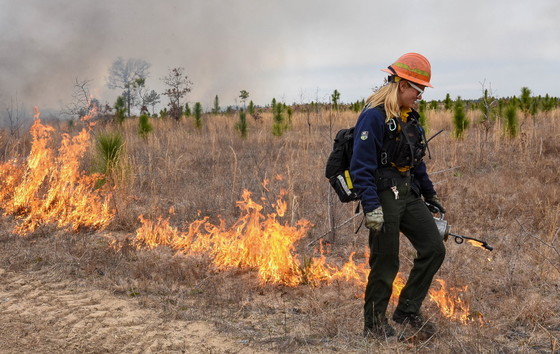 Prescribed burns, such as this one at Sprewell Bluff, have lowered wildfire risks in the South. (Hal Massie/DNR)
(audio) "Why the South is ahead of the West in wildfire prevention," NPR
2021 virtual CoastFest videos, DNR
"Ocean drone captures video from inside hurricane," NOAA
"Appalachian Trail thru-hike (97 days in five minutes)," Dino Inc.
"Striped skunk kits," DNR
"Midnight prey delivery by great horned owls," Landings Bird Cam, Savannah
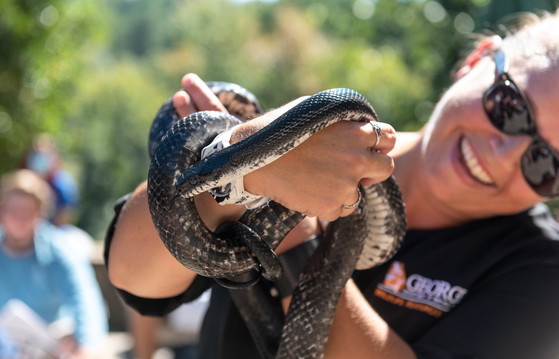 Kathy Church shows a rat snake during the Tallulah Falls program (E. Lane Gresham/Tallulah Falls School)
Kathy Church, a DNR wildlife interpretive specialist, explained and explored Georgia’s snakes with Outdoor Education Class students at Tallulah Falls School Oct. 4. Students at the northeast Georgia school learned about the benefits of snakes, their importance to the ecosystem and how to handle encounters with them. Church works at Smithgall Woods Regional Education Center near Helen.
Top
|